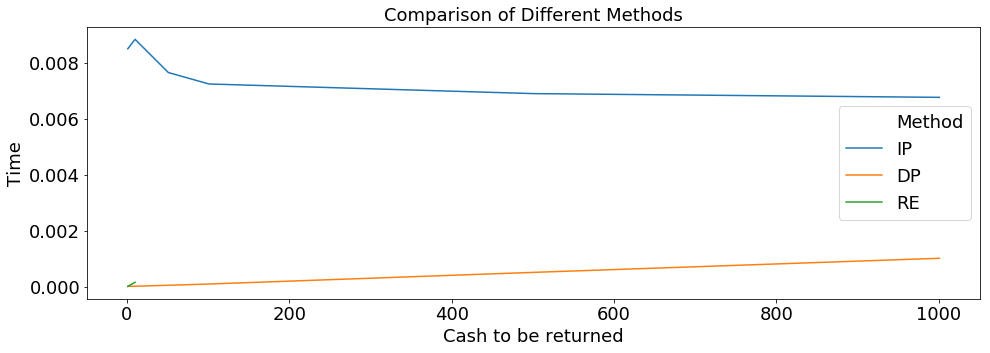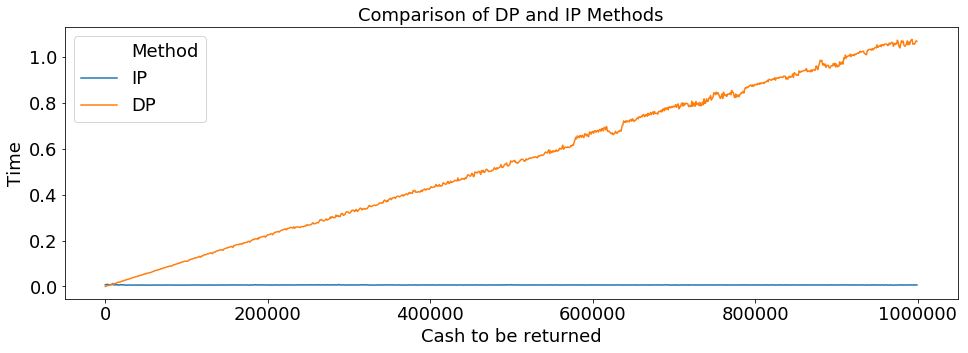Coin-changing (Knapsack problem)
So a friend of mine was interviewing for a semi-software focused position which had also a time-restricted technical test.
One of the questions asked was something along these lines:
A vending machine has been recently installed on your work floor!
Unfortunately, there is a limit on the number of bills it can hold, so the technicians would like a way to give out the minimum amount of change in bills needed.
So, your task is the following:
Write a program that given an initial amount of money (the change to be returned), find the minimum number of bills (of certain denominations) that add up to it.
Our machine can give back only bills of 1,2,5 and 10$!
A pretty straightforward problem that many CS students have already seen during their Algorithms101 or CS101 classes.
It was also featured in xkcd:

This problem is essentially a variation of a Knapsack Problem. This is a more relevant lemma but there is an unlimited amount of blogs, posts etc on this matter and I won’t delve much on the technical details.
As we were discussing it, I was trying to come up with a fast solution. Although I knew that Dynamic Programming was the way to go with this problem, my skills regarding classical CS and algos are a bit rusty, so it would take me some time to remember the inner-workings of the approach..
(Note to self: Head over to GFG to stretch out!)
Solved as an integer programming problem
Thus, I opted for an optimization approach. As, we would like to minimize the number of bills given back, the obvious choice would be an Integer Programming approach, as the count of each denomination will be non-negative integers.
Let:
- $w \in \mathbb{Z}^N$, be the array with the $N$ available denominations
- $X \in \mathbb{Z}^N$, be the count of each denomination returned
- $C \in \mathbb{Z}$, be the wanted amount of cash to be returned
The problem formulation would be :
$$ min\sum{X}$$
with the restraints:
- $x \geq 0, \forall x \in X$ (we need a non-negative amount of each denomination)
- $Χ\cdot w^Τ = C$ (they must sum up to the needed cash)
That’s it. We have formulated the problems and the constraints and we just need the appropriate solver to run the procedure. For my approach python 3 is used.
We will rely on the cvxopt package.
We will also need the GLPK_MI package for the solver, as the ECOS_BB is not working correctly. Check out the docs on how to do so
def solve_with_ip(denominations, CASH):
"""
Input:
- denominations: iterable,
a list/array/iterable with the available integer denominations
- CASH: int,
the needed amount of cash
Output:
- if the minimization is feasible, a dictionary is returned with
keys each denomination and values their corresponding count
"""
import cvxpy as cp
# The available coin denominations e.g. a 2-dollar bill, a 5-dollar bill and a 10-dollar bill.
w = cp.Constant(denominations)
# The initial cash to be changed
CASH = cp.Constant(CASH)
# Variables containing the number of the coins to be returned for each denominator
# The size of this must be equal to the denominations w
x = cp.Variable((1, w.shape[0]), integer=True)
# We want to minimize the total number of coins returned
objective = cp.Minimize(cp.sum(x))
# The constraints
constraints = [
w@x.T == CASH, #
x>=0 # semi-positive coins
]
# Form and solve problem.
prob = cp.Problem(objective, constraints)
# Need the GLPK_MI solver because the ECOS_BB is not working correctly.
prob.solve(solver = 'GLPK_MI') # Returns the optimal value.
if prob.status == 'infeasible':
print("Can't change %s with denominations: %s"%(CASH.__str__(), w.__str__()))
return -1
else:
#return
print("Initial cash %s is changed into %d coins as follows:"%(CASH.__str__(), prob.value))
res = dict(zip([w_ for w_ in w.value], x.value.flatten()))
print(res)
return res
denominations = [1, 2, 5, 10]
CASH = 100
_ = solve_with_ip(denominations, CASH)
Competition
Let’s see how it plays out against two simple strategies found on GeeksforGeeks
import sys
def solve_with_greedy(denominations, CASH):
"""
Greedy approach
!! THIS APPROACH DOES NOT RETURN CORRECT RESULTS
!! FOR EXAMPLE IF WE HAVE denominations [2,5,10]
!! AND WE ASK FOR CASH = 6 THE RESULT WOULD BE
!! ONE 5 BILL AND NOTHING ELSE
"""
n = len(denominations)
# Initialize Result
ans = []
# Traverse through all denomination
i = n - 1
while(i >= 0):
# Find denominations
while (CASH >= denominations[i]):
CASH -= denominations[i]
ans.append(denominations[i])
i -= 1
return ans
def solve_with_re(denominations, CASH):
"""
Recursive approach
"""
m = len(denominations)
# base case
if (CASH == 0):
return 0
# Initialize result
res = sys.maxsize
# Try every coin that has smaller value than V
for i in range(0, m):
if (denominations[i] <= CASH):
sub_res = solve_with_re(denominations, CASH - denominations[i])
# Check for INT_MAX to avoid overflow and see if
# result can minimized
if (sub_res != sys.maxsize and sub_res + 1 < res):
res = sub_res + 1
return res
def solve_with_dp(denominations, CASH):
"""
DP_approach
"""
m = len(denominations)
# table[i] will be storing the minimum
# number of coins required for i value.
# So table[V] will have result
table = [0 for i in range(CASH + 1)]
# Base case (If given value V is 0)
table[0] = 0
# Initialize all table values as Infinite
for i in range(1, CASH + 1):
table[i] = sys.maxsize
# Compute minimum coins required
# for all values from 1 to V
for i in range(1, CASH + 1):
# Go through all coins smaller than i
for j in range(m):
if (denominations[j] <= i):
sub_res = table[i - denominations[j]]
if (sub_res != sys.maxsize and
sub_res + 1 < table[i]):
table[i] = sub_res + 1
return table[CASH]
print(solve_with_re(denominations, 15))
print(solve_with_greedy(denominations, 15))
print(solve_with_dp(denominations, 15))
OK, so everything is working as it should. Let’s run a test-suite and see how this goes
import pandas as pd
from time import time
import numpy as np
methods_names = ["IP", "DP", "RE"]
methods = [solve_with_ip, solve_with_dp, solve_with_re]
test_instances = [1, 10, 51, 101, 501, 1001] #np.random.randint(11, 10000, size=10000)
denominations = [1, 2, 5, 10]
logs = []
for name, method in zip(methods_names, methods):
t_s1 = time()
for CASH in test_instances:
t_s = time()
_ = method(denominations, CASH)
logs.append({"Method":name, "Test":CASH, "Time":time()-t_s})
print("%s finished all tests in %0.2f seconds!"%(name, time()-t_s1))
import seaborn as sns;
import matplotlib.pyplot as plt
import matplotlib
%matplotlib inline
df = pd.DataFrame(logs)
fig = plt.figure(figsize=(16,5))
SMALL_SIZE = 18
matplotlib.rc('font', size=SMALL_SIZE)
matplotlib.rc('axes', titlesize=SMALL_SIZE)
sns.lineplot(x='Test', y='Time', hue='Method', data=df)
plt.xlabel("Cash to be returned")
plt.title("Comparison of Different Methods")
plt.show()

Well as expected the RE method is by far the slowest one. In fact it was so slow, I had to interrupt it from running for all test cases. So, we won’t focus on this one.
Regarding the two main-contenders, we can see than the DP one seems to be faster and not affected by the amount of cash to be returned. We can see a hint of linear dependence to the cash to be returned but this is more of a guess/intuition rather than an insight gained from the graph.
This is somewhat expected as Dynamic Programming works well when the states table is small. This happens because the states that have to be visited are small in number and it can be easy to navigate through them to find the optimal solution.
On the other hand, the IP method seems to take up some time for the initial small values, but then the time needed seems constant regardless of the value cash returned. However, this constant plateau is still worse than the time needed for the DP method.
But what happens, when we change the scale of things?
Let’s run another experiment with much larger values and evaluate the results of the DP and IP methods.
import pandas as pd
from time import time
import numpy as np
methods_names = ["IP", "DP"]
methods = [solve_with_ip, solve_with_dp]
test_instances = np.arange(1000000, step=1000)
denominations = [1, 2, 5, 10]
logs = []
for name, method in zip(methods_names, methods):
t_s1 = time()
for CASH in test_instances:
t_s = time()
_ = method(denominations, CASH)
logs.append({"Method":name, "Test":CASH, "Time":time()-t_s})
print("%s finished all tests in %0.2f seconds!"%(name, time()-t_s1))
import seaborn as sns;
import matplotlib.pyplot as plt
import matplotlib
%matplotlib inline
df = pd.DataFrame(logs)
fig = plt.figure(figsize=(16,5))
SMALL_SIZE = 18
matplotlib.rc('font', size=SMALL_SIZE)
matplotlib.rc('axes', titlesize=SMALL_SIZE)
sns.lineplot(x='Test', y='Time', hue='Method', data=df)
plt.xlabel("Cash to be returned")
plt.ylabel("Time in seconds")
plt.title("Comparison of DP and IP Methods")
plt.show()

Aha!
As we can see the roles have drastically changed.
This is expected as the overall time needed for DP based approach is along the lines of:
Number-of-states $\times$ evaluation-time-per-state
With constant evaluation time per state, as we increase the possible number of states (the value to be returned) we see a linear increase to the time needed.
On the other hand, the IP approach does not suffer from such issues. We see a constant time of $\approx0.04$ seconds regardless of the cash needed.
This is to be expected as the only thing that changes in the optimization problem is the constant of the CASH needed for the second constraint. As such, the performance would be the same regardless of the value returned. Moreover, the solver GNU Linear Programming Kit- GLPK used is very efficient in mixed integer programs.
Conclusion
So a few final words regarding this post.
We visited the problem of Coin-Changing and formulated it as an Integer Programming problem. We evaluated a solver on this problem, alongside some classic recursive and dynamic programming procedures. Finally, we performed the two tests, on different scales of input to benchmark the approaches in a simple way.
The analysis done here is by no means perfect. I am sure there are more efficient implementations for both the IP and DP approaches presented here, but this was more of a proof-of-concept and thought-provoking experimentation rather than a complete benchmark.
I hope to have some more time to check the initial performance bump of the IP method (for values of CASH < 200) that seems rather unnatural to me.
As a tl;dr closing remarks I would state the following:
- If you’d like you could formulate the coin-change problem as an IP problem. This is an approach I have not yet seen.
- Is it worth the effort? Firstly, the effort in terms of lines of code is not so big, as demonstrated. Secondly, regarding the results, if the coin-change machine in your workplace is expected to give out change in the scale of > 10000$, then it is crucial. If not, don’t bother with it.
- With regards to the interview itself, I think it would be interesting to see the reaction of the technical supervisor when presented with this approach. If it were me, I would give a (+) to the candidate for the originality of the idea though.
- Finally, as a note to self, do not forget to brush-up your knowledge on simple CS/Algo problems before heading in a technical interview.
If you have any comments or spot any mistakes/errors, feel free to contact me or leave a comment!